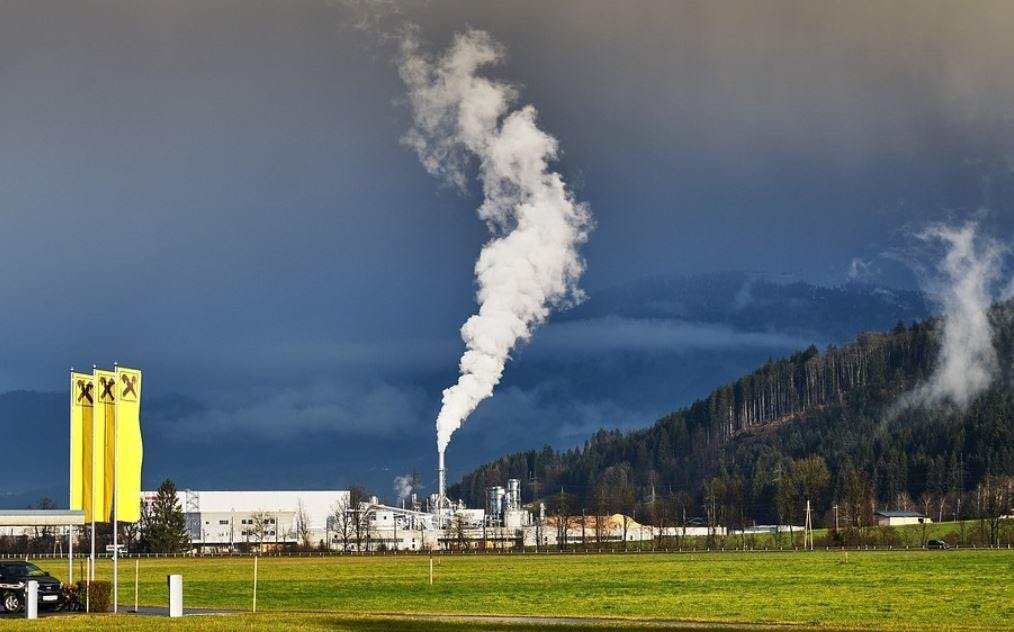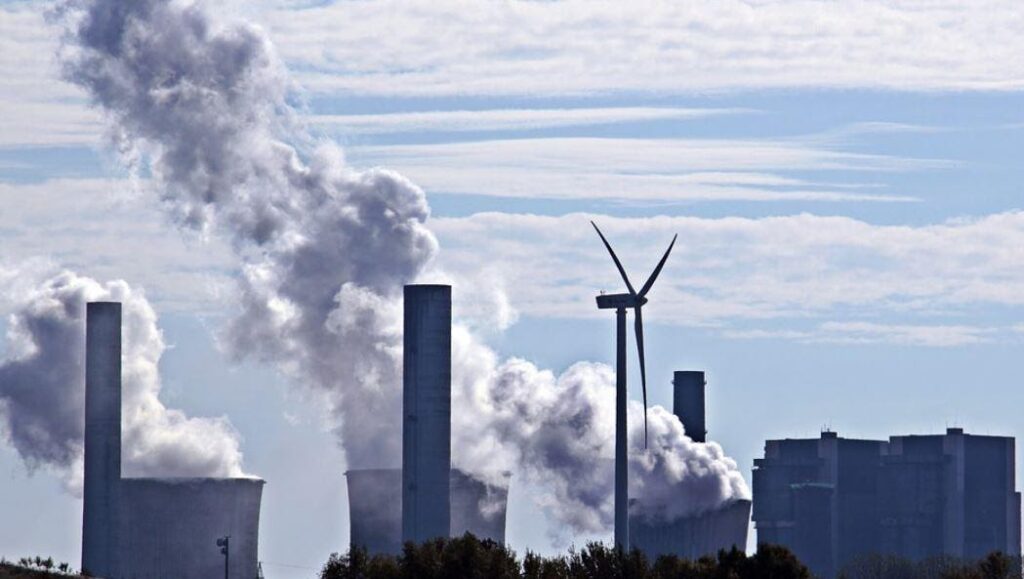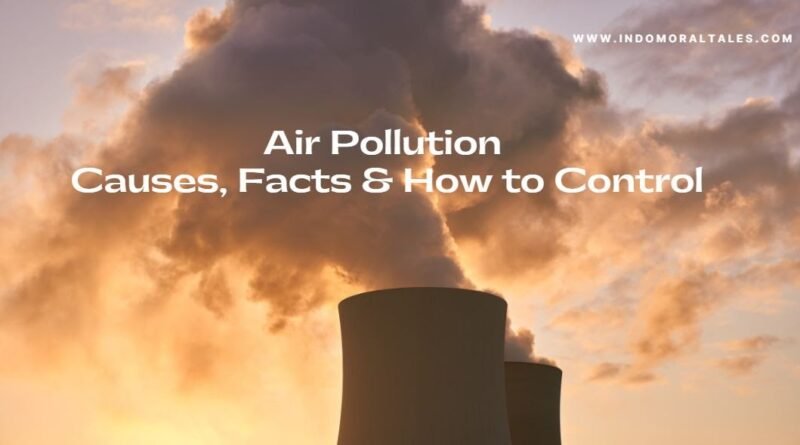Air Pollution Essay in English
The air pollution essay is one of the important essays for children in classes 6-10. Here we gave two samples of essays on air pollution. We hope they can help you in understanding and prepare a short paragraph on air pollution or a long essay on air pollution. The points covered here also help students to understand what is air pollution, what are the causes of air pollution, the types of air pollution, and the steps to prevent air pollution.
Quick Navigation
Air pollution Essay in 250 words
Air pollution is the presence of harmful chemicals in the air. It disturbs air quality and makes it unfit for human inhaling. When humans inhale air that is contaminated with external substances, it causes serious health issues.
Air pollution even affects animals, aquatic life, and buildings too. The impact of polluted air on people suffering from breathing problems like asthma, allergies can be intense. It is also harmful to pregnant women, children, and the elderly, though it is dangerous to anyone.
The main reasons for air pollution are chemicals emitted from vehicles and factories. Forest fires and agricultural waste burning also contribute to air pollution. Additionally, cities that have mountains around face high levels of air pollution. This is because the air gets trapped inside the city and cannot move in and out freely.
In severe cases, humans die by inhaling polluted air. The bhopal tragedy is one instance where millions were injured and thousands were killed spontaneously.
The only way to curb air pollution is to increase awareness in people about its causes and results. We should switch to electric vehicles and grow a greater number of trees everywhere possible. By using public transport and walking or cycling to nearby areas, we can make the air fresh again. Air pollution is a serious hazard to humans that needs everyone’s participation to control it. 15+ Ideas to Celebrate Republic Day in School
Air Pollution Long Essay
Air pollution has been a long-running problem for humans. Right from the start of industrialization and urbanization, we have been facing this problem. However, though many types of research and studies are alerting about the harmful effects of air pollution, the levels of pollutants in the air are increasing year after year.
What is air pollution?
Air pollution is the decline in the quality of air due to the addition of particles and lethal gases.
When air is polluted, its natural composition is disturbed. It means the levels of gases change and poisonous gases become more in level than beneficial gases. The most common sources of air pollution include particulate matter, ozone, nitrogen dioxide, and sulfur dioxide.
Causes of air pollution
There are various causes of air pollution – natural, and man-made.

Volcano eruptions: When volcanoes erupt, they emit many gases and substances. Sulfur dioxide, carbon dioxide, and hydrogen fluoride are the main chemicals volcanoes release into the air. All these three are threats to humans and the environment.
Sulphuric acid is the main reason for acid rain. Additionally, volcanoes also release tremendous amounts of ash that travel miles from the point of eruption. This causes air pollution in the places nearby the volcano. Air mixed with ash and its particulates is harmful to breathing. The impact on pregnant women and children is worse due to such air.
Forest fires: Forest fires are one major threat to the whole globe. For any reason, if a forest catches fire, it can become uncontrollable and spread within no time. The blazes kill hundreds of animals living in the forest while the fires cannot be easily controlled by humans. The recent forest fires that humanity witnessed in 2020 were forest fires in Russia, California, and Australia.
NASA estimates that the impact of forest fires of Russia is dangerous on the Siberian icebergs. It may cause their melting and thus increase the sea level across the globe. The forest fires release uncontrollable levels of carbon-di-oxide into the air along with other greenhouse gases.
Radon accumulation: Radon is a radioactive gas that is released by Earth’s crust due to the radioactive process. It is found in closed areas like parking spaces below the ground level. It is one of the most harmful gases and causes threats next to cigarette smoke.
No vegetation areas: In dry arid areas that have no trees or vegetation, airflow pulls up the sand and dust into the air. This adds particles into the air which causes breathing problems to humans and irritates human eyes.
Cattle: Animals and ruminants like a cow in specific, contribute to the release of methane, a poisonous gas into the air. During the natural process of digestion and excretion, cows release methane. When cows are stocked at a place for turning them into food, such areas experience more methane levels.
What are greenhouse gases?
Gases that trap the earth’s heat without allowing it to escape into the atmosphere increasing the Earth’s temperature are called greenhouse gases.
Carbon dioxide, methane, nitrous oxide, and fluorinated gases are some of the harmful greenhouse gases that are released from various industries and vehicle emissions.
Human-Made Causes of Air Pollution
Factory emissions: The gases released from factories are a dangerous threat to air quality. The pollutants released into the air from factory emissions include carbon dioxide, sulfur dioxide, nitrogen oxides, carbon monoxide, and methane.
Researchers observed that since the introduction of factories and industrialization, the levels of carbon dioxide have increased dramatically in the air. Fossil fuel power plants, coal industries, biomass industries, and incinerators all contribute to air pollution. The levels of CO2 in the air are 280 parts per million and 410 parts per million before and after industrialization. This clearly shows that man-made pollution is more in proportion to natural causes.
Emissions from vehicles: Vehicles that run on fossil fuels like petrol and diesel release nitrogen oxide into the air. The deaths due to vehicle emissions are as high as 65,000 in the Middle East Countries, according to reports. The gases released from the burning of fossil fuels are one of the main causes of air pollution.
Agricultural waste burning: Farmers in many parts of the world burn the residues of the plant after harvest. After this, they clear the land and prepare it for the next harvest season. IN this process, a lot of poisonous gases are released along with the smoke. This is one of the main causes of air pollution in rural areas.
Usage of firewood stoves: Even today many households in remote places use firewood for cooking. Similarly, many industries use coal and firewood for burning and heating purposes in a closed or confined space that has the least ventilation for the smoke to escape. This is another cause of air pollution in such places. Similarly, the usage of kerosene stoves is also another source that is polluting the air.
Burning of waste in open areas: Waste should be burnt in regulated incinerators. Instead, it is an illegal practice that most people to burn waste materials in outdoor places. This is another major contributor to air pollution.
Indoor air pollution: Air pollution not only exists in the outside air but exists in the air inside the houses too. The usage of chemicals to clean the house, air fresheners, paints, chemical sprays, synthetic incense, etc. can create indoor air pollution. The dry-cleaning process and dry-cleaned clothes also release harmful gases into the air even after days of dry cleaning.
Surprisingly, there are many other causes of indoor air pollution. Carpeting, plywood, hair, and fur of pets, dust mites in the beds and pillows, skin and hair released by humans, pollen, and micro-organisms living with indoor plants all contribute to indoor air pollution. Additionally, poor ventilation and improper chimney functioning also increase the amounts of carbon monoxide inside houses and cause suffocation.

Shocking Facts about Air Pollution
According to the World Health Organization (WHO):
- Every year 4.2 million deaths happen because of air pollution.
- More than 92 percent of the world’s population is living in highly air-polluted areas.
- India is one of the countries that have air pollution levels beyond safe levels. Worryingly, 13 out of the 20 top polluted cities in the world are in India, according to 2013 reports.
- Air pollution kills millions in the world just next to smoking. The number of deaths due to air pollution is as much as due to smoking.
- According to 2012 studies, the number of deaths across the globe caused by air pollution is more than those caused by AIDS, road accidents, and tuberculosis together.
- Particulate air pollution, where tiny particles are present in polluted air is another threat. Particles less than 2.5 micrometers penetrate the lungs and can cause lung cancer.
What are the effects of air pollution?
Air pollution has many effects – on human health, nature, agriculture, economy, and monuments too.
Impact of air pollution on human health
- Polluted air can damage the lungs irreparably. The particulate matter enters the lungs directly and causes lung cancer.
- The number of deaths due to air pollution is highest in India. The main reason for air pollution-related deaths is the nitrogen dioxide and nitrogen oxide released from vehicles.
- Air pollution is another prime factor for stroke and heart disease. People living near traffic areas are in the high-risk zone and are prone to lung cancer.
- Many premature deaths have also been reported due to air pollution.
- The risk of neurological disorders is high in children when pregnant women are exposed to air pollution. Also, mothers who were exposed to polluted air gave birth to children with lower birth weight.

Impact of air pollution on agriculture
Air pollution affects plants too. Crops grown in polluted air are shown to possess lesser chlorophyll content, reduced leaf cross-section, and mass.
Impact of air pollution on the economy
Air pollution affects countries economically too. Countries with high air pollution levels have higher child mortality rates. The harmful effects of air pollution are also adding to medical costs and reduced productivity in those countries.
Steps to control air pollution
Natural causes for air pollution are not in human control. But, we can take care of human-made causes of air pollution and do our best to save the quality of air and our health.
Shift to renewable energy: If we can curb the usage of fossil fuels and shift to renewable energy, air pollution levels will come down rapidly. For example, use solar-powered lights for backup instead of diesel generators. Use solar-powered stoves instead of firewood stoves.
Similarly,
- Replace petrol and diesel-run bikes with electric bikes
- Strict implementation of air quality regulations for industries and vehicles.
- Not burning waste in open places.
- Educating people about the harmful effects of air pollution and creating awareness.
- Shifting to cycling and public transport instead of using cars and bikes for every purpose.
- Completely stopping the use of vehicles for 2 days a week.
- Planting more trees can enhance the quality of air.
- Reducing the usage of chemicals and Air conditioners in the home.
- Stopping eating animal-based products will bring down methane levels sharply.
- Wearing masks to prevent the inhalation of particulate pollutants in the polluted air.
Conclusion of Air Pollution Essay
Human beings might survive a couple of days without water. But if there is no availability of air, humans cannot survive more than 4 minutes! This explains why air pollution is a dangerous threat to living beings on Earth. Air pollution is a threat that may affect generations to come if not curbed immediately. Let us implement at least one single measure that we can and create awareness to make the air clean and pure again.




